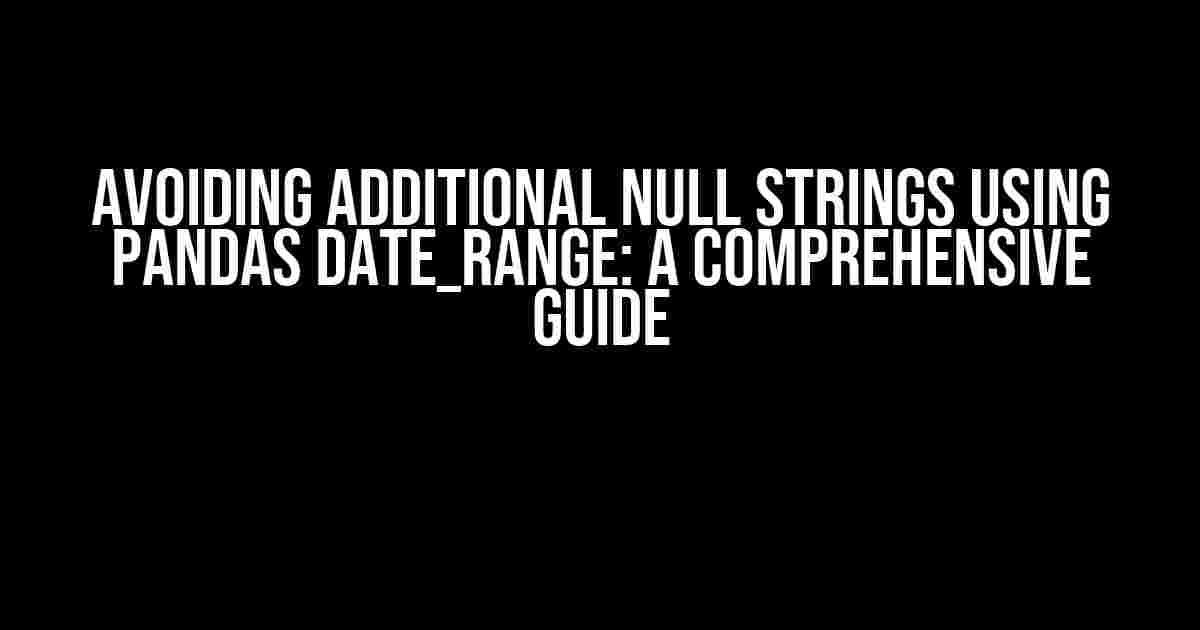When working with dates in Python, Pandas’ date_range function is an essential tool for generating sequences of dates. However, have you ever encountered the frustrating issue of additional null strings creeping into your date range? In this article, we’ll delve into the world of Pandas’ date_range and explore the secrets to avoiding those pesky null strings, ensuring your date ranges are clean, efficient, and easy to work with.
What is Pandas’ date_range?
date_range is a powerful function in the Pandas library that allows you to generate a sequence of dates and timestamps. It’s commonly used for creating datetime indices for DataFrames, resampling data, and performing various time-series analyses. The function takes several parameters, including the start and end dates, frequency, and optional parameters for specifying the date range’s characteristics.
import pandas as pd
date_range = pd.date_range(start='2022-01-01', end='2022-01-31', freq='D')
print(date_range)The Problem: Additional Null Strings
When generating date ranges using date_range, you might encounter unexpected null strings in the resulting sequence. These null strings can cause issues when working with your date range, such as:
- Incorrect date formatting
- Errors in date-based calculations
- Inconsistent data analysis results
The primary reason for these additional null strings is the default behavior of date_range, which includes NaT (Not a Time) values at the beginning and end of the sequence if the start or end dates don’t exactly match the specified frequency. To avoid these null strings, we need to understand how to effectively use the date_range parameters.
Parameter Tweaking: The Key to Success
The secret to avoiding additional null strings lies in carefully adjusting the date_range parameters. Let’s explore the key parameters that can make all the difference:
1. start and end Parameters
The start and end parameters specify the beginning and end dates of the date range. Make sure to set them correctly to avoid any NaT values:
import pandas as pd
date_range = pd.date_range(start='2022-01-01', end='2022-01-31', freq='D')
print(date_range)2. freq Parameter
The freq parameter defines the frequency of the date range. Common frequencies include:
- D: daily frequency
- H: hourly frequency
- M: monthly frequency
- Q: quarterly frequency
- Y: yearly frequency
Choose the correct frequency to match your date range requirements:
import pandas as pd
date_range = pd.date_range(start='2022-01-01', end='2022-01-31', freq='H')
print(date_range)3. closed Parameter
The closed parameter determines whether the start and end dates are inclusive or exclusive. Set it to 'left', 'right', or 'both' to control the date range boundaries:
import pandas as pd
date_range = pd.date_range(start='2022-01-01', end='2022-01-31', freq='D', closed='left')
print(date_range)4. normalize Parameter
The normalize parameter allows you to normalize the start and end dates to midnight. This can help eliminate NaT values by ensuring the dates align with the specified frequency:
import pandas as pd
date_range = pd.date_range(start='2022-01-01 10:30:00', end='2022-01-31 20:45:00', freq='D', normalize=True)
print(date_range)Real-World Scenarios: Putting it all Together
Now that we’ve explored the key parameters, let’s apply this knowledge to real-world scenarios:
Scenario 1: Generating a Date Range for a Specific Month
Suppose you want to generate a date range for the month of January 2022, ensuring no additional null strings:
import pandas as pd
date_range = pd.date_range(start='2022-01-01', end='2022-01-31', freq='D')
print(date_range)Scenario 2: Creating a Date Range with a Specific Frequency
Imagine you need to generate a date range with an hourly frequency, starting from January 1st, 2022, 10:00 AM, and ending on January 31st, 2022, 11:00 PM:
import pandas as pd
date_range = pd.date_range(start='2022-01-01 10:00:00', end='2022-01-31 23:00:00', freq='H', normalize=True)
print(date_range)Scenario 3: Excluding Weekends from a Date Range
Suppose you want to generate a date range, excluding weekends (Saturdays and Sundays), for the month of February 2022:
import pandas as pd
date_range = pd.date_range(start='2022-02-01', end='2022-02-28', freq='B')
print(date_range)Conclusion
In this comprehensive guide, we’ve delved into the world of Pandas’ date_range and explored the secrets to avoiding additional null strings. By mastering the art of parameter tweaking, you’ll be able to generate clean, efficient, and accurate date ranges for your data analysis and manipulation needs. Remember to carefully adjust the start, end, freq, closed, and normalize parameters to achieve the desired results. With practice and patience, you’ll become a pro at working with Pandas’ date_range and unlock the full potential of your date-based data.
Additional Resources
For further learning and exploration, we recommend checking out the following resources:
- Pandas documentation: pd.date_range
- Pandas tutorials: Time Series / Date functionality
- Python documentation: datetime module
| Scenario | Date Range | Frequency | Normalized |
|---|---|---|---|
| Monthly Date Range | 2022-01-01 to 2022-01-31 | Daily | No |
| Hourly Date Range | 2022-01-01 10:00:00 to 2022-01-31 23:00:00 | Hourly | Yes |
| Excluding Weekends | 2022-02-01 to 2022-02-28 | Business Days | No |
By mastering the art of date_range, you’ll be well-equipped to tackle even the most complex date-based challenges in your Python projects. Happy coding!
Frequently Asked Question
Are you tired of dealing with additional null strings when using Pandas date_range? We’ve got you covered!
Q1: What is the default behavior of Pandas date_range when generating a sequence of dates?
By default, Pandas date_range includes the end date in the generated sequence, which can lead to additional null strings if the end date is not explicitly specified.
Q2: How can I avoid additional null strings when using Pandas date_range?
To avoid additional null strings, you can set the `periods` parameter to a specific value, instead of relying on the default behavior. This ensures that the generated sequence stops at the desired end date.
Q3: What is the difference between `date_range` and `bdate_range` in Pandas?
`date_range` generates a sequence of dates, including non-business days, whereas `bdate_range` generates a sequence of business days only, excluding weekends and holidays.
Q4: Can I specify a custom frequency when using Pandas date_range?
Yes, you can specify a custom frequency using the `freq` parameter. For example, you can use `freq=’M’` for monthly frequency, `freq=’Q’` for quarterly frequency, and so on.
Q5: How can I generate a sequence of dates with a specific timezone using Pandas date_range?
You can specify the timezone using the `tz` parameter. For example, `date_range(start=’2022-01-01′, periods=10, tz=’US/Eastern’)` generates a sequence of dates in the US/Eastern timezone.


